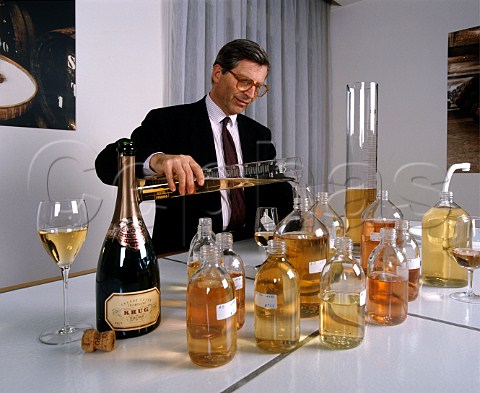May 20, 2024
The Méthode Champenoise: An Overview Of How Champagne is Made

Champagne, the iconic sparkling wine from the Champagne region of France, is renowned for its elegance, complexity, and effervescence. The method used to produce Champagne, known as the "Méthode Champenoise" or "Traditional Method," is a meticulous process that has been perfected over centuries. This detailed overview explores each step of this intricate production method, highlighting the key processes that contribute to the creation of this prestigious wine.
The Méthode Champenoise: An Overview
The Méthode Champenoise involves several stages, including grape harvesting, primary fermentation, blending, secondary fermentation, aging, riddling, disgorging, dosage, and final corking. Each step is crucial to developing the unique characteristics and quality of Champagne.
1. Grape Harvesting
The production of Champagne begins with the careful selection and harvesting of grapes. Only specific grape varieties are permitted in Champagne production: Chardonnay, Pinot Noir, and Pinot Meunier. The harvest typically occurs in September, with grapes picked by hand to ensure only the best fruit is used. The timing of the harvest is critical, as grapes must be at the optimal balance of sugar and acidity.
2. Pressing and Primary Fermentation
Once harvested, the grapes are quickly transported to the press house. Gentle pressing is essential to extract the juice without crushing the seeds, which can impart bitterness. The juice, known as "must," is then transferred to stainless steel tanks or oak barrels for primary fermentation. During this stage, natural or added yeasts convert the sugars in the grape juice into alcohol and carbon dioxide, resulting in a still wine known as "vin clair."

Photo: Krug blending their editions
3. Blending (Assemblage)
Blending, or assemblage, is a defining step in Champagne production. Winemakers blend different base wines from various vineyards, grape varieties, and vintages to achieve the desired style and consistency. The ability to blend is considered an art, requiring skill and experience. This process allows Champagne houses to maintain a consistent house style year after year.
4. Secondary Fermentation (Tirage)
After blending, the wine undergoes secondary fermentation, a critical phase that creates Champagne's signature bubbles. The blended wine is bottled, and a mixture of sugar and yeast, known as the "liqueur de tirage," is added before sealing the bottles with a temporary cap. The bottles are then stored horizontally in cool, dark cellars. During this stage, which lasts several weeks, the yeast consumes the added sugar, producing alcohol and carbon dioxide. Since the bottles are sealed, the carbon dioxide dissolves into the wine, creating bubbles.
5. Aging on the Lees
Following secondary fermentation, the wine ages on its lees (dead yeast cells) for an extended period. This ageing process is critical for developing the complex flavours and creamy texture characteristic of fine Champagne. Non-vintage Champagnes must age for a minimum of 15 months, while vintage Champagnes require at least three years. However, many high-quality Champagnes are aged much longer, sometimes up to a decade or more.

Photo: The riding process
6. Riddling (Remuage)
Once the ageing process is complete, the bottles undergo riddling, or remuage, to consolidate the sediment (lees) at the neck of the bottle. Traditionally, this was done by hand on a riddling rack, with a "remueur" gradually rotating and tilting each bottle over several weeks. Today, many producers use automated machines called "gyropalettes" to expedite this process. Riddling ensures that the sediment can be easily removed during disgorging.
7. Disgorging (Dégorgement)
Disgorging, or dégorgement, involves removing the sediment from the bottle. The neck of the bottle is frozen, creating a plug of frozen lees. When the temporary cap is removed, the pressure inside the bottle forces the plug out, leaving clear, sparkling wine behind. This process is quick but requires precision to ensure minimal loss of wine and pressure.
8. Dosage
After disgorging, the wine is topped up with a mixture of wine and sugar, known as the "liqueur d'expédition" or dosage. The amount of sugar in the dosage determines the sweetness level of the final Champagne, classified as Brut Nature (no added sugar), Extra Brut, Brut, Extra Dry, Sec, Demi-Sec, or Doux. Most Champagnes are Brut, which contains very little sugar.
Photo: discorgement process
9. Final Corking and Aging
Finally, the bottles are sealed with the traditional cork and wire cage. Some Champagnes undergo additional ageing in the bottle after disgorging, allowing the wine to integrate and develop further complexity. This final ageing period can range from a few months to several years, depending on the producer's style and the wine's intended market.
10. Labeling and Packaging
The finished Champagne is labelled and packaged for sale. The label provides important information, including the producer, the region, the sweetness level, and, if applicable, the vintage year. High-end Champagnes often feature luxurious packaging to reflect their premium status.
The Méthode Champenoise is a labour-intensive and time-consuming process, but it is essential for creating the unique quality and character of Champagne. Each step, from grape harvesting to final corking, contributes to the wine's complexity, elegance, and effervescence. The meticulous craftsmanship and dedication of Champagne producers ensure that every bottle delivers the exceptional experience that has made Champagne a symbol of celebration and luxury around the world. By understanding the intricate production method, one can better appreciate the artistry and tradition that go into every bottle of this prestigious sparkling wine.
To see and shop all of our champagnes - click here


